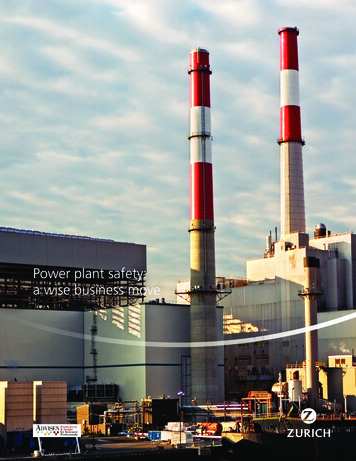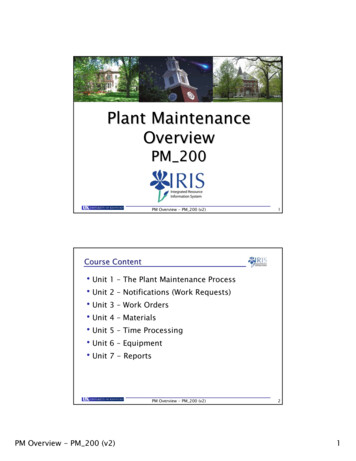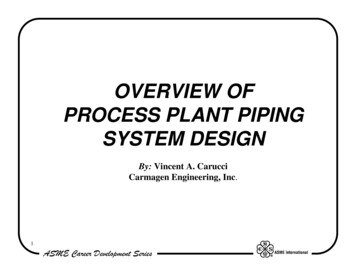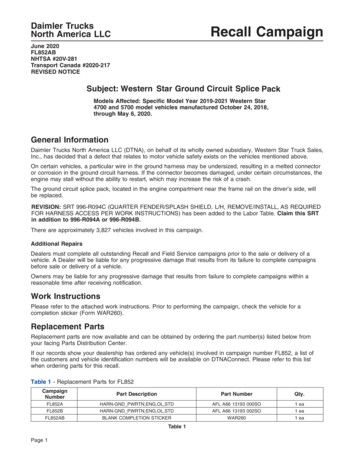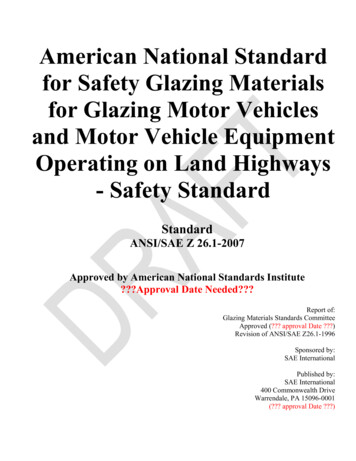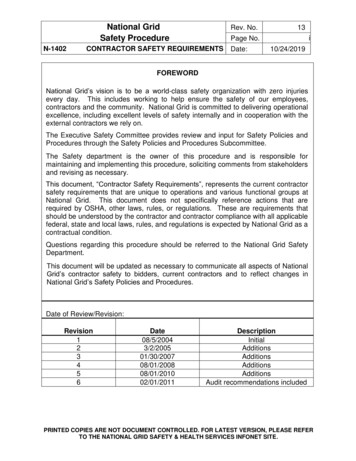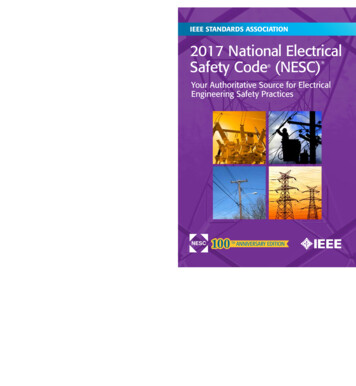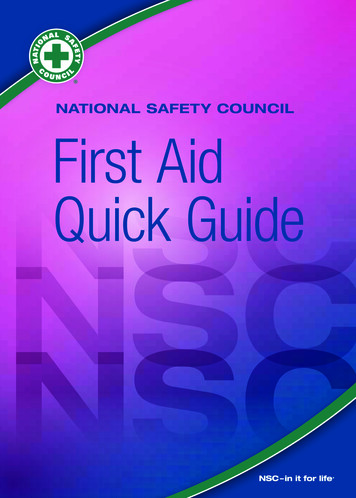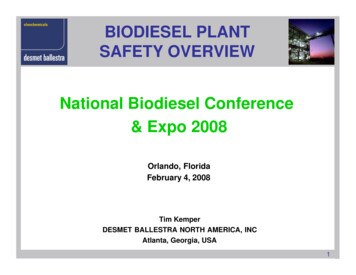
Transcription
BIODIESEL PLANTSAFETY OVERVIEWNational Biodiesel Conference& Expo 2008Orlando, FloridaFebruary 4, 2008Tim KemperDESMET BALLESTRA NORTH AMERICA, INCAtlanta, Georgia, USA1
BIODIESEL PLANTSAFETY OVERVIEWTOPICSà BIODIESEL BASICS NFPA COMPLIANCE EPA COMPLIANCE OSHA COMPLIANCE2
BIODIESEL PLANTSAFETY OVERVIEWBIODIESEL BASICS(1) veg oil (3) methanol(3) biodiesel (1) glycerinsodium methoxide1 x mw 884 3 x mw 3299.6 lbs 10.8 lbs3 x mw 296 1 x mw 92100.0 lbs 10.4 lbs Approximately 100 pounds of vegetable oil and10 pounds of methanol react to form 100 poundsof biodiesel and 10 pounds of glycerin.3
BIODIESEL PLANTSAFETY OVERVIEWBIODIESEL BASICS The methanol and sodium methoxide used in thebiodiesel process are the primary areas of concern forbiodiesel plant safety. A typical 30 mmgy biodiesel plant will consume about65,000 lbs of methanol and 11,000 lbs of 30% sodiummethoxide catalyst per day, both flammable liquids.4
BIODIESEL PLANTSAFETY OVERVIEWBIODIESEL BASICS Both methanol and sodium methoxide are flammableliquids and present a fire and explosion hazard whichrequires compliance with NFPA regulations. Both methanol and sodium methoxide are toxic and canpresent health hazards which requires compliance withboth OSHA and EPA regulations.5
BIODIESEL PLANTSAFETY OVERVIEWTOPICSü BIODIESEL BASICSà NFPA COMPLIANCE EPA COMPLIANCE OSHA COMPLIANCE6
BIODIESEL PLANTSAFETY OVERVIEWNFPA LIQUID CODES Flammable Class IA: 73 F flash point & 100 F b.p. Flammable Class IB: 73 F flash point & 100 F b.p. Flammable Class IC:73 – 100 F flash point Combustible Class II:100 -140 F flash point Combustible Class IIIA: 140 - 200 F flash point Combustible Class IIIB: 200 F flash point7
BIODIESEL PLANTSAFETY OVERVIEWNFPA LIQUID CODES Vegetable oil Combustible Class IIIB Liquid Biodiesel Combustible Class IIIB Liquid Glycerin Combustible Class IIIB Liquid ** Methanol Flammable Class IB Liquid Sodium Methoxide Flammable Class IB Liquid** If below 2000 ppm methanol.8
BIODIESEL PLANTSAFETY OVERVIEWNFPA COMPLIANCE NFPA 30 Flammable and Combustible Liquids Codeapplies for the process as well as the tank farm,including vegetable oil, biodiesel, glycerin, methanoland sodium methoxide tanks. NFPA 30 chapters 1-6 contains tank design specs, tankfarm spacing requirements, emergency pressure reliefventing requirements, fire protection requirements, etc. NFPA 30 chapter 7 contains operations requirements,including the biodiesel process building.9
BIODIESEL PLANTSAFETY OVERVIEWNFPA COMPLIANCE NFPA 30 chapter 7 requires a minimum of 25 feetbetween process equipment and adjoining buildings orproperty lines.Hazardous Areas5 ft rventBiodiesel Process3 ft r1.5 ft1.5 ft25 ft25 ft10
BIODIESEL PLANTSAFETY OVERVIEWNFPA COMPLIANCE NFPA 30 chapter 7 requires a process buildingminimum ventilation of 1 cfm/ft2 of solid floor areaoperating anytime there is flammable or combustibleliquid in the building. This minimizes the potential of aflammable mixture or toxic level of methanol in the air. NFPA 30 chapter 7 requires control of ignition sources,such as no smoking, no hot work, etc. All potentialspark-producing devices should remain outside thehazardous area unless a hot-work permit is issued.11
BIODIESEL PLANTSAFETY OVERVIEWNFPA COMPLIANCE NFPA 30 chapter 8 requires proper electrical systemsfor hazardous areas as per NFPA 497 Classifications ofHazardous Locations for Electrical Installations inHazardous AreasChemical Process Areas.5 ft rventBiodiesel Process3 ft r1.5 ft1.5 ft25 ft25 ft12
BIODIESEL PLANTSAFETY OVERVIEWNFPA COMPLIANCE NFPA 497 lists methanol vapor as having a flammabilityrange of 6.0-36.0% by volume in air. This means thatwithin this mixture, the vapor is flammable & explosive! Have a portable gas monitor available to check the% of LEL (lower explosive limit 6%) to insure aflammable mixture is not present during operation.100% of LEL0% of LELpure airpure methanol vapor6%36%flammable & explosive mixture13
BIODIESEL PLANTSAFETY OVERVIEWNFPA COMPLIANCE NFPA 497 lists methanol vapor as a having avapor density equal to 1.1 times that of air. Methanolvapor will sink in the building and collect in low places.Insure that the ventilation fans are always operating!fresh airlouvervapor releaseexhaust airexhaust fan14
BIODIESEL PLANTSAFETY OVERVIEWNFPA COMPLIANCE NFPA 497 is used to identify those areas in andadjacent to the process area that are class 1, division 1,group D explosion proof classification and those areasthat are class 1, division 2, group D explosion proofclassification. NFPA 497 provides a series of figures for determiningthe horizontal and vertical dimensions of the classifiedareas.15
BIODIESEL PLANTSAFETY OVERVIEWNFPA COMPLIANCE In adequately ventilated buildings, the division 1classification is generally limited to the area below thecurb elevation of the biodiesel process and the sphereof 5 ft radius around the process vent discharge. Theremaining process area is considered division 2. A division 2 zone generally surrounds the processbuilding as well at a distance extending 25 feet from thebuilding horizontally and 1.5 feet above grade vertically.16
BIODIESEL PLANTSAFETY OVERVIEWNFPA COMPLIANCE NFPA 70 National Electric Code provides the detailelectrical apparatus specs for each area classification. Motors, lights, instruments, etc. must meet theminimum requirements for a class 1, division 2, group Dexplosion proof classification.17
BIODIESEL PLANTSAFETY OVERVIEWTOPICSü BIODIESEL BASICSü NFPA COMPLIANCEà EPA COMPLIANCE OSHA COMPLIANCE18
BIODIESEL PLANTSAFETY OVERVIEWEPA COMPLIANCECAS No. Chemical Name razine7647010 Hydrochloric acid7664393 Hydrogen fluoride7783064 Hydrogen ne108316Maleic anhydride67561Methanol72435Methoxychlor74839Methyl bromide Methanol is onthe list of 188 EPA“hazardous air pollutants”19
BIODIESEL PLANTSAFETY OVERVIEWEPA COMPLIANCE All biodiesel plants require that an air permitapplication be filed with the EPA prior to construction. The amount of methanol lost to the atmosphere willdetermine the complexity and duration of the permittingprocess. Annual methanol losses exceeding 10 tons willcategorize a biodiesel plant as a “major source” ofhazardous air pollutants, lengthening the process.20
BIODIESEL PLANTSAFETY OVERVIEWEPA COMPLIANCE The EPA requires that the vent of the biodieselprocess be scrubbed with best available controltechnology (BACT) to remove 98% of the methanol fromthe vapors leaving the process. The EPA requires monitoring and recording of keyparameters of the vent gas scrubbing system. Methanol storage tanks need to either be vented intothe process vent scrubbing system, or have their ownEPA approved vapor recovery system.21
BIODIESEL PLANTSAFETY OVERVIEWTOPICSü BIODIESEL BASICSü NFPA COMPLIANCEü EPA COMPLIANCEà OSHA COMPLIANCE22
BIODIESEL PLANTSAFETY OVERVIEWOSHA COMPLIANCEIs Methanol Poisonous? YES! As with many other fuels,methanol can be highly toxic and should never be takenorally. A few teaspoons of methanol can cause blindnessand a few tablespoons can be fatal, if the exposure is nottreated. It should be noted that the human body canmetabolize and eliminate low concentrations of methanolwith no ill effects. (Methanol is present in many cookedvegetables, and the artificial sweetener in diet soft drinksbreaks down into methanol during digestion.) Methanolbecomes poisonous only when it overwhelms the body’scapacity to remove it.23
BIODIESEL PLANTSAFETY OVERVIEWOSHA COMPLIANCEToxic effects do not occur until several hours afterexposure. Effective antidotes to methanol poisoning arereadily available and can be administered during thisinterim period. If someone ingests methanol orally, or issubject to large amount of methanol skin exposure orbreathes substantial vapor, take them to the emergencyroom for immediate treatment!OSHA Permissible Exposure Limit (PEL) 260 mg/m3which is 216 ppm or about 0.3% of LEL.24
BIODIESEL PLANTSAFETY OVERVIEWOSHA COMPLIANCEOSHA 29 CFR 1910.119PROCESS SAFETY MANAGEMENT OF HIGHLY HAZARDOUS CHEMICALS.Purpose. This section contains requirements for preventing or minimizingthe consequences of catastrophic releases of toxic, reactive, flammable, orexplosive chemicals. These releases may result in toxic, fire or explosionhazards.(a) Application. (1) This section applies to the following:(ii) A process which involves a flammable liquid or gas on site in onelocation, in a quantity of 10,000 pounds (4535.9 kg) or more.PSM applies to all biodiesel plants!25
BIODIESEL PLANTSAFETY OVERVIEWOSHA COMPLIANCEOSHA 29 CFR 1910.119PROCESS SAFETY MANAGEMENT OF HIGHLY HAZARDOUS CHEMICALS.(b) Definitions.(c) Employee participation.-- All employees must be engaged in the PSM process.(d) Process safety information.-- MSDS’s must be on hand for employees to review. Acids and caustics inaddition to methanol and sodium methoxide need special handling care.(e) Process hazard analysis.-- A HAZOP analysis is a recommended method for process hazard analysisfor biodiesel plants and must be completed prior to start-up.26
BIODIESEL PLANTSAFETY OVERVIEWOSHA COMPLIANCEOSHA 29 CFR 1910.119PROCESS SAFETY MANAGEMENT OF HIGHLY HAZARDOUS CHEMICALS.(f) Operating procedures.-- Written procedures for start-up, operation shutdown, emergencies, etc.must be in place prior to start-up.(g) Training.-- Must be conducted before start-up, for new employees, and refresherevery 3 years, etc.(h) Contractors.-- Maintenance contractor training program must be in place such thatcontractors receive proper safety training before entering thehazardous area.27
BIODIESEL PLANTSAFETY OVERVIEWOSHA COMPLIANCEOSHA 29 CFR 1910.119PROCESS SAFETY MANAGEMENT OF HIGHLY HAZARDOUS CHEMICALS.(i) Pre-startup safety review.-- Checklist to insure all PSM is in place prior to start-up.(j) Mechanical Integrity.-- Verify vessel wall thicknesses are sufficient, pressure relief devices areworking, etc. on an ongoing basis.(k) Hot work permit.-- Issued prior to any cutting, welding, etc. to insure area is safe. OSHA1910.106(h)(7)(ii) defines when a hot-work permit may be issued. Allcombustibles within 35 feet must be removed and the immediate areamust be purged free of methanol vapor.28
BIODIESEL PLANTSAFETY OVERVIEWOSHA COMPLIANCEOSHA 29 CFR 1910.119PROCESS SAFETY MANAGEMENT OF HIGHLY HAZARDOUS CHEMICALS.(l) Management of change.-- Process for documenting and training on process changes. P&IDs andoperating instructions must be kept up to date.(m) Incident investigation.-- Investigation within 48 hours of any potential methanol release.(n) Emergency planning and response.-- An emergency response plan for the entire plant.(o) Compliance audits.-- Every 3 years to insure compliance with PSM requirements.29
BIODIESEL PLANTSAFETY OVERVIEWTOPICSü BIODIESEL BASICSü NFPA COMPLIANCEü EPA COMPLIANCEü OSHA COMPLIANCE30
BIODIESEL PLANTSAFETY OVERVIEWAlways remember production second.31
NFPA COMPLIANCE NFPA 497 is used to identify those areas in and adjacent to the process area that are class 1, division 1, group D explosion proof classification and those areas that are class 1, division 2, group D explosion proof classification. NFPA 497 provides a series of figures for determining the horizontal and vertical dimensions of the classified areas. BIODIESEL PLANT SAFETY .

